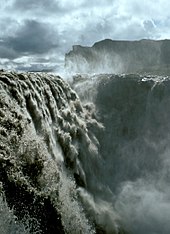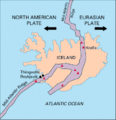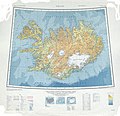| Revision as of 01:44, 3 June 2014 edit50.46.169.10 (talk)No edit summary← Previous edit | Revision as of 01:44, 3 June 2014 edit undoClueBot NG (talk | contribs)Bots, Pending changes reviewers, Rollbackers6,439,388 editsm Reverting possible vandalism by 50.46.169.10 to version by Flyer22. False positive? Report it. Thanks, ClueBot NG. (1862061) (Bot)Next edit → | ||
| Line 2: | Line 2: | ||
| {{Refimprove|date=May 2012}} | {{Refimprove|date=May 2012}} | ||
| {{Infobox islands | {{Infobox islands | ||
| | name = Iceland |
| name = Iceland | ||
| | image name = CIA Factbook map of Iceland.png | | image name = CIA Factbook map of Iceland.png | ||
| | image caption = Map of Iceland | | image caption = Map of Iceland | ||
Revision as of 01:44, 3 June 2014
| This article was imported from the CIA's World Factbook. Please help rewrite this article. (May 2012) |
| This article needs additional citations for verification. Please help improve this article by adding citations to reliable sources. Unsourced material may be challenged and removed. Find sources: "Geography of Iceland" – news · newspapers · books · scholar · JSTOR (May 2012) (Learn how and when to remove this message) |
| Nickname: Land of Fire and Ice | |
|---|---|
| Geography | |
| Location | Atlantic Ocean |
| Coordinates | 65°00′N 18°00′W / 65.000°N 18.000°W / 65.000; -18.000 |
| Area | 103,001 km (39,769 sq mi) |
| Area rank | 18th |
| Coastline | 4,970 km (3088 mi) |
| Highest elevation | 2,110 m (6920 ft) |
| Administration | |
| Iceland | |
| Demographics | |
| Population | 316,252 |
| Pop. density | 3.1/km (8/sq mi) |
The geography of Iceland entails the geographic features of Iceland, an island country at the confluence of the North Atlantic and Arctic Oceans. Iceland is located east of Greenland and immediately south of the Arctic Circle, atop the constructive boundary of the northern Mid-Atlantic Ridge. It lies about 860 km (534 mi) from Scotland and 4,200 km (2,610 mi) from New York City. One of the world's most sparsely populated countries, the republic of Iceland is almost completely coterminous with the main island – the world's 18th largest in area and possessing almost all of the country's area and population.
Iceland has extensive volcanic and geothermal activity. The rift associated with the Mid-Atlantic Ridge, which marks the division between the European and North American tectonic plates, runs across Iceland from the southwest to the northeast. This geographic feature is prominent at the Þingvellir National Park, where the promontory creates an extraordinary natural amphitheatre. The site was the home of Iceland's parliament, the Alþing, which was first convened in 930. It is a common misconception that Þingvellir are located at the juncture between the North American and Eurasian continental plates. However, they are in fact at the juncture of the North American continental plate and a smaller plate (approx. 10,000 km2) called the Hreppar Microplate (Hreppaflekinn).
About half of Iceland's land area, which is of recent volcanic origin, consists of a mountainous lava desert (highest elevation 2,119 m (6,952 ft) above sea level) and other wasteland. Eleven percent is covered by three large glaciers:
- Vatnajökull (8300 km²)
- Langjökull (953 km²)
- Hofsjökull (925 km²)
and several smaller ones:
- Mýrdalsjökull (695 km²)
- Drangajökull (199 km²)
- Eyjafjallajökull (107 km²)
- Snæfellsjökull.
Twenty percent of the land is used for grazing, and only 1% is cultivated. An ambitious reforestation program is under way. Fossilized tree pollen and descriptions by the early settlers indicate that prior to human settlement in the 9th–10th century, trees covered about 30 – 40 percent of the island. Today, however, there are only small patches of the original birch forests left, the most prominent are Hallormsstaðarskógur and Vaglaskógur.
The inhabited areas are on the coast, particularly in the southwest; the central highlands are totally uninhabited.
Because of the Gulf Stream's moderating influence, the climate is characterized by damp, cool summers and relatively mild but windy winters. In Reykjavík, the average temperature is 11 °C (51.8 °F) in July and 0 °C (32 °F) in January (Köppen: Cfc).
Statistics

- Geographic coordinates
- Northern Europe (for cultural and historical reasons it is not considered to be a part of North America), between the Greenland Sea and the North Atlantic Ocean, northwest of the British Isles.
- 65°00′N 18°00′W / 65.000°N 18.000°W / 65.000; -18.000
- North: Rifstangi, 66°32′3" N (Kolbeinsey, 67°08,9 N)
- South: Kötlutangi, 63°23′6" N (Surtsey, 63°17,7 N)
- West: Bjargtangar, 24°32′1" W
- East: Gerpir, 13°29′6" W (Hvalbakur, 13°16,6 W)
- Map references
- Arctic Region
- Area
- 39,769 sq miles (103,001 km²)
- Total: 103,125 km²
- Land: 100,329 km²
- Water: 2,796 km²
- Land boundaries
- 0 km
- Coastline
- 4,970 km
- Maritime claims
-
- Continental shelf: 200 nmi (370.4 km; 230.2 mi) or to the edge of the continental margin
- Exclusive economic zone: 200 nmi (370.4 km; 230.2 mi)
- Territorial sea: 12 nmi (22.2 km; 13.8 mi)
- Climate
- Temperate; moderated by North Atlantic Current; mild, windy winters; cool summers, damp in the South and West
- Terrain
- Mostly plateau interspersed with mountain peaks, icefields; coast deeply indented by bays and fjords
- Elevation extremes
-
- Lowest point: Jökulsárlón Lagoon: -146 m, Atlantic Ocean 0 m
- Highest point: Hvannadalshnúkur 2,110 m
- Natural resources
- Fish, hydropower, geothermal power, diatomite
- Land use
-
- Arable land: 1.19%
- Permanent crops: 0%
- Other: 98.81% (2011)
- Irrigated land
- NA
- Total renewable water resources
- 170 km
- Natural hazards
- Earthquakes, volcanic activity, avalanches, and glacial lake outburst flooding (or jökulhlaups)
- Environment—current issues
- Water pollution from fertilizer runoff; inadequate wastewater treatment
- Environment—international agreements
-
- Party to: Air Pollution, Air Pollution-Persistent Organic Pollutants, Biodiversity, Climate Change, Desertification, Endangered Species, Hazardous Wastes, Law of the Sea, Marine Dumping, Nuclear Test Ban, Ozone Layer Protection, Ship Pollution (MARPOL 73/78), Wetlands, Whaling
- Signed, but not ratified: Environmental Modification, Marine Life Conservation
- Geography—note
- Westernmost European country; more land covered by glaciers than in all of continental Europe
Antipodes
Iceland is not antipodal to any land mass. The closest are the Balleny Islands off Antarctica, claimed by New Zealand. The antipodes of the northernmost of these, Young Island, lie between Flatey and Grímsey Islands off the north central Icelandic coast, about 10 km from either.
Maps and Images
-
 True colour satellite image of Iceland in winter
True colour satellite image of Iceland in winter
-
 Satellite image of Iceland
Satellite image of Iceland
-
 Map of Iceland showing major towns and geographical features
Map of Iceland showing major towns and geographical features
-
 Active volcanic areas and systems in Iceland
Active volcanic areas and systems in Iceland
-
 Map showing the Mid-Atlantic Ridge splitting Iceland and separating the North American and Eurasian Plates
Map showing the Mid-Atlantic Ridge splitting Iceland and separating the North American and Eurasian Plates
-
 Ridge between the tectonic plates of Eurasia and North America
Ridge between the tectonic plates of Eurasia and North America
-
 Iceland is rich in sulfur deposits.
Iceland is rich in sulfur deposits.
-
 Topographic map of Iceland
Topographic map of Iceland
See also
- Extreme points of Europe
- Extreme points of Iceland
- Fjords of Iceland
- Highlands of Iceland
- Iceland hotspot
- Iceland plume
- Lakes of Iceland
- List of islands off Iceland
- List of national parks of Iceland
- List of valleys of Iceland
- Rivers of Iceland
- Waterfalls of Iceland
References
- "Plate boundaries, rifts and transforms in Iceland" (PDF). JÖKULL No. 58, 2008. Institute of Earth Sciences, University of Iceland. Retrieved 19 March 2014.
- "Iceland". The World Factbook. CIA. Retrieved 6 May 2012.
External links
| Iceland articles | |||||||
|---|---|---|---|---|---|---|---|
| History |
|  | |||||
| Geography |
| ||||||
| Politics | |||||||
| Economy | |||||||
| Society |
| ||||||
| Geography of Europe | |
|---|---|
| Sovereign states |
|
| States with limited recognition | |
| Dependencies and other entities | |
| Other entities | |